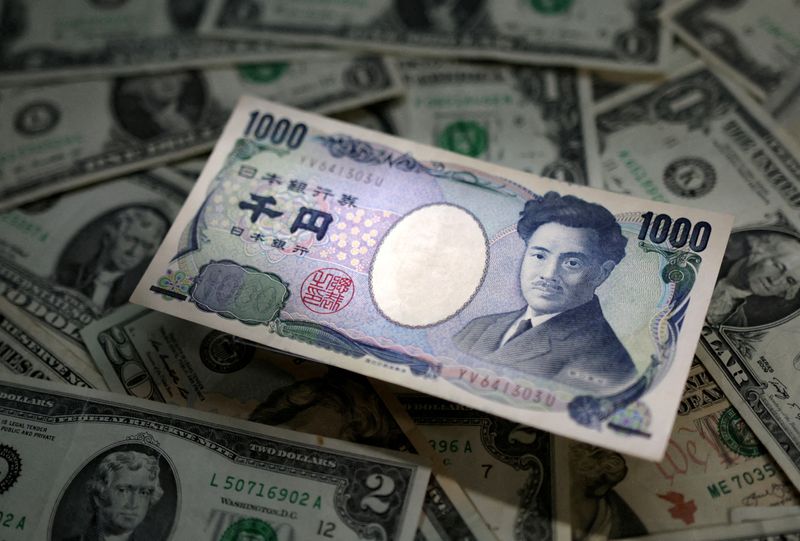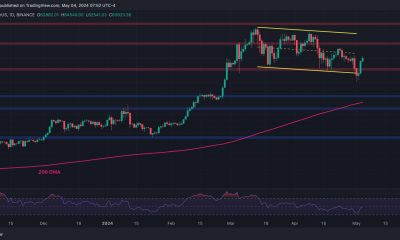Economy
Dollar pares losses after data shows some inflation remains sticky


© Reuters. FILE PHOTO: Japanese Yen and U.S. dollar banknotes are seen in this illustration taken March 10, 2023. REUTERS/Dado Ruvic/Illustration
By Karen Brettell
NEW YORK (Reuters) -The dollar pared losses against the euro and yen on Tuesday after data showed that some underlying measures of inflation remained relatively elevated in November even as price gains came in broadly as expected.
Headline inflation edged up 0.1% last month after being unchanged in October. In the 12 months through November, the CPI increased 3.1% after rising 3.2% in October. Economists polled by Reuters had forecast CPI would be unchanged on the month and gain 3.1% on a year-on-year basis.
Excluding the volatile food and energy components, the CPI increased 0.3% in November after climbing 0.2% in the prior month. But so-called supercore inflation, which tracks the cost of services minus energy and housing, rose 0.44% in the month up from 0.22% in October.
“Once we dig into the data we can see that some of the underlying numbers are perhaps a little sticky, particularly the supercore numbers,” said Shaun Osborne, chief foreign exchange strategist at Scotiabank in Toronto.
“Generally we’ve seen sufficient progress on inflation to keep a rate cut as the next move, but it’s really about the timing at this point and these numbers suggest that we still need to see some further progress on some of these underlying measures before the Fed will be comfortable cutting interest rates,” Osborne added.
Traders pushed back expectations on when the Federal Reserve is likely to begin cutting interest rates to May, from March, after data on Friday showed that employers added more jobs than expected in November.
Fed officials are due to release their updated economic and interest rate projections at the conclusion of the U.S. central bank’s two-day meeting on Wednesday. Fed Chairman Jerome Powell may also push back against expectations for a rate cut in the first half of 2024.
The greenback had dropped before the data as traders positioned for a dovish number.
The dollar was last down 0.09% on the day against a basket of currencies at 103.95. It got as low as 103.48 immediately after the data, before bouncing.
The euro was last up 0.13% at $1.0779. It was around $1.0809 before the data. The greenback was last down 0.41% at 145.59 Japanese yen, after earlier getting as low as 144.75.
The yen has been volatile on speculation that the Bank of Japan may be closer to ending its negative rate policy. Hopes that this may occur as soon as next week were dashed after Bloomberg reported on Monday that BOJ officials see little need to rush as they have not seen enough evidence of wage growth to justify sustainable inflation.
Later this week the European Central Bank, Bank of England, Norges Bank and the Swiss National Bank all meet, with Norway considered the only which could potentially raise rates. There is also a risk the SNB could dial back its support for the franc in FX markets.
In cryptocurrencies, gained 0.25% to $41,323.
========================================================
Currency bid prices at 10:20AM (1520 GMT)
Description RIC Last U.S. Close Pct Change YTD Pct High Bid Low Bid
Previous Change
Session
Dollar index 103.9500 104.0600 -0.09% 0.444% +104.0900 +103.4800
Euro/Dollar $1.0779 $1.0765 +0.13% +0.60% +$1.0830 +$1.0762
Dollar/Yen 145.5900 146.1950 -0.41% +11.05% +146.1850 +144.7450
Euro/Yen 156.93 157.31 -0.24% +11.85% +157.3400 +156.5100
Dollar/Swiss 0.8768 0.8787 -0.17% -5.13% +0.8785 +0.8724
Sterling/Dollar $1.2540 $1.2555 -0.10% +3.71% +$1.2615 +$1.2516
Dollar/Canadian 1.3602 1.3574 +0.21% +0.39% +1.3616 +1.3545
Aussie/Dollar $0.6551 $0.6568 -0.29% -3.93% +$0.6612 +$0.6540
Euro/Swiss 0.9451 0.9452 -0.01% -4.49% +0.9479 +0.9435
Euro/Sterling 0.8595 0.8571 +0.28% -2.82% +0.8608 +0.8558
NZ $0.6118 $0.6124 -0.13% -3.69% +$0.6169 +$0.6106
Dollar/Dollar
Dollar/Norway 10.9840 10.9540 +0.32% +11.97% +11.0140 +10.8800
Euro/Norway 11.8420 11.7908 +0.43% +12.85% +11.8658 +11.7537
Dollar/Sweden 10.4736 10.4864 +0.02% +0.63% +10.5124 +10.4209
Euro/Sweden 11.2909 11.2892 +0.02% +1.27% +11.3223 +11.2637
Economy
Russian central bank says it needs months to make sure CPI falling before rate cuts -RBC


© Reuters. Russian Central Bank Governor Elvira Nabiullina attends a news conference in Moscow, Russia June 14, 2019. REUTERS/Shamil Zhumatov/File Photo
MOSCOW (Reuters) – Russia’s central bank will need two to three months to make sure that inflation is steadily declining before taking any decision on interest rate cuts, the bank’s governor Elvira Nabiullina told RBC media on Sunday.
The central bank raised its key interest rate by 100 basis points to 16% earlier in December, hiking for the fifth consecutive meeting in response to stubborn inflation, and suggested that its tightening cycle was nearly over.
Nabiullina said it was not yet clear when exactly the regulator would start cutting rates, however.
“We really need to make sure that inflation is steadily decreasing, that these are not one-off factors that can affect the rate of price growth in a particular month,” she said.
Nabiullina said the bank was taking into account a wide range of indicators but primarily those that “characterize the stability of inflation”.
“This will take two or three months or more – it depends on how much the wide range of indicators that characterize sustainable inflation declines,” she said.
The bank will next convene to set its benchmark rate on Feb. 16.
The governor also said the bank should have started monetary policy tightening earlier than in July, when it embarked on the rate-hiking cycle.
Economy
China identifies second set of projects in $140 billion spending plan


© Reuters. FILE PHOTO: Workers walk past an under-construction area with completed office towers in the background, in Shenzhen’s Qianhai new district, Guangdong province, China August 25, 2023. REUTERS/David Kirton/File Photo
SHANGHAI (Reuters) – China’s top planning body said on Saturday it had identified a second batch of public investment projects, including flood control and disaster relief programmes, under a bond issuance and investment plan announced in October to boost the economy.
With the latest tranche, China has now earmarked more than 800 billion yuan of its 1 trillion yuan ($140 billion) in additional government bond issuance in the fourth quarter, as it focuses on fiscal steps to shore up the flagging economy.
The National Development and Reform Commission (NDRC) said in a statement on Saturday it had identified 9,600 projects with planned investment of more than 560 billion yuan.
China’s economy, the world’s second largest, is struggling to regain its footing post-COVID-19 as policymakers grapple with tepid consumer demand, weak exports, falling foreign investment and a deepening real estate crisis.
The 1 trillion yuan in additional bond issuance will widen China’s 2023 budget deficit ratio to around 3.8 percent from 3 percent, the state-run Xinhua news agency has said.
“Construction of the projects will improve China’s flood control system, emergency response mechanism and disaster relief capabilities, and better protect people’s lives and property, so it is very significant,” the NDRC said.
The agency said it will coordinate with other government bodies to make sure that funds are allocated speedily for investment and that high standards of quality are maintained in project construction.
($1 = 7.1315 renminbi)
Economy
Russian central bank says it needs months to make sure CPI falling before rate cuts -RBC


© Reuters. Russian Central Bank Governor Elvira Nabiullina attends a news conference in Moscow, Russia June 14, 2019. REUTERS/Shamil Zhumatov/File Photo
MOSCOW (Reuters) – Russia’s central bank will need two to three months to make sure that inflation is steadily declining before taking any decision on interest rate cuts, the bank’s governor Elvira Nabiullina told RBC media on Sunday.
The central bank raised its key interest rate by 100 basis points to 16% earlier in December, hiking for the fifth consecutive meeting in response to stubborn inflation, and suggested that its tightening cycle was nearly over.
Nabiullina said it was not yet clear when exactly the regulator would start cutting rates, however.
“We really need to make sure that inflation is steadily decreasing, that these are not one-off factors that can affect the rate of price growth in a particular month,” she said.
Nabiullina said the bank was taking into account a wide range of indicators but primarily those that “characterize the stability of inflation”.
“This will take two or three months or more – it depends on how much the wide range of indicators that characterize sustainable inflation declines,” she said.
The bank will next convene to set its benchmark rate on Feb. 16.
The governor also said the bank should have started monetary policy tightening earlier than in July, when it embarked on the rate-hiking cycle.

 Forex2 years ago
Forex2 years agoForex Today: the dollar is gaining strength amid gloomy sentiment at the start of the Fed’s week

 Forex2 years ago
Forex2 years agoHow is the Australian dollar doing today?

 Forex1 year ago
Forex1 year agoUnbiased review of Pocket Option broker

 Forex2 years ago
Forex2 years agoDollar to pound sterling exchange rate today: Pound plummeted to its lowest since 1985

 Cryptocurrency2 years ago
Cryptocurrency2 years agoWhat happened in the crypto market – current events today

 World2 years ago
World2 years agoWhy are modern video games an art form?

 Stock Markets2 years ago
Stock Markets2 years agoMorgan Stanley: bear market rally to continue

 Economy2 years ago
Economy2 years agoCrude oil tankers double in price due to EU anti-Russian sanctions

































